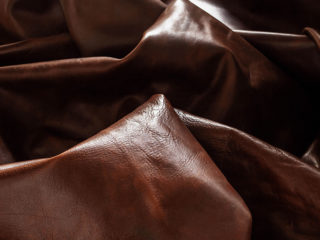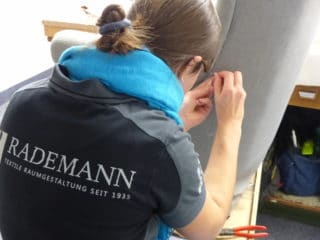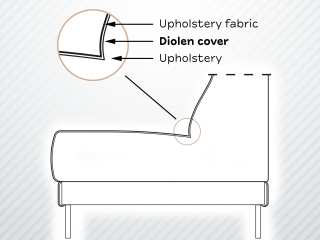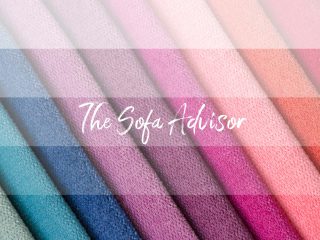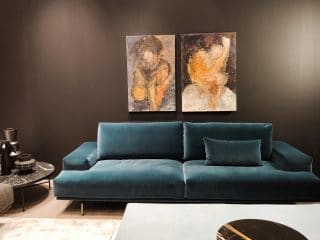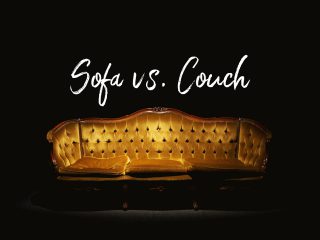Overview
Leather production: Artfully refined nature. Today, leather is more than just a material. While there used to be no substitute for animal skins, many people today consciously opt for genuine leather. For shoes or belts, leather is almost considered a must. Clothing made of genuine leather is pleasing and well-regarded. And a leather-covered sofa is considered the epitome of upscale home decor. Leather is a cultural asset.
What is it that makes leather so fascinating to us?
Perfect by nature? An expensive rarity!
The quality and appearance of a leather strongly depends on the expert execution of a complex processing process, which we will learn more about below. In addition, however, another factor plays an essential, perhaps even the decisive role: the natural beauty of the grown natural material! Because no two hides are exactly alike. Even if two cattle come from the same parents and have spent their lives on the same pasture, their hides will not be completely alike.
This natural individuality of each skin is also what makes leather something very special. This is also one of the greatest challenges for leather production. Because every hide is different, the raw material must be sorted piece by piece. This requires the hand and the eye of the expert. Only he can recognize which hide has such a perfectly grown grain (= the visible surface of the leather) that it is suitable for the highest quality leather.

Photo: Photolifestyle / ADOBESTOCK
And only the expert can tell which hides are similar enough to be made into a sofa later. Because for a three-seater sofa you need about 6 cattle hides. In the end, these should together produce a surface that is as harmonious as possible.
Expert selection of the hides for further processing is therefore crucial – and has a major influence on both the quality and price of the end product!
Natural skin – artistic leather
Leather is often referred to as a natural product. Understandable, because after all it consists of the natural skin of animals. While for shoes, belts, bags and clothing also skins of sheep, pigs or goats are used, for furniture it is almost exclusively the skins of cattle. But do not worry: the cow does not lose its life for a sofa! As a rule, the animal is slaughtered for its meat. The hide is a waste product, so to speak, for which there is a good possibility of use thanks to the art of the tanner. So the raw material does not have to be wasted.
Today, however, no one would want to have the literally “natural” skin of animals on or around them permanently. Without tanning, the material would simply not be durable, it would decompose (or, to be more precise, decompose), it would tear even under relatively light use, and it would not look as beautiful as the leather fan would like. It is the art of the tanner that turns raw animal hides into the desirable, noble material that is leather. But what exactly does this art consist of?
Tanning, dyeing, dressing – leather production is a complex process
The art of leather production consists in transforming the natural, perishable raw material skin into a durable substance that has certain properties depending on its intended use.
For use as upholstery leather, the focus is on properties such as water resistance, stability, robustness, lightfastness, color fastness, but also skin-friendliness, breathability, softness and pleasant feel. Last but not least, there are also a wide variety of visual and aesthetic properties: sometimes the leather should be robust and look as natural as possible, sometimes it should be particularly fine, elegant and uniform. To achieve this, a large number of work steps are necessary, which can be divided into the preparation of the hide, the actual tanning of the hide into leather and the subsequent finishing of the leather. In detail, this process can look very different, because it depends very much on the type of leather that is to be produced.
Can tanning also be done “cleanly”?
From time immemorial, the tanning of leather was considered a dirty business. Working with the skin of dead animals caused considerable hygienic problems. The substances used as tanning agents, tanning aids or dyes often made matters worse. Smoke tanning over wood fires is the oldest method of preserving hides, and it already left formaldehyde residues in the leather, which people did not know about at the time, but whose skin-irritating effects they experienced firsthand. People helped themselves by washing and drying the tanned hides several times.
The use of “aggressive”, i.e. effective, substances is also essential for tanning today. This is because the actual tanning process consists of a chemical-physical reaction that must be triggered by the addition of the tanning substance and other auxiliary substances. It causes the tanning substance to penetrate deep into the skin, where it forms a permanent bond with the protein (collagen) present in the skin. This transforms the raw, perishable hide fiber into a new, durable and hard-wearing fiber, leather.
To achieve this transformation, plants (= vegetable tanning), minerals or metals (esp. chromium salts) and synthetically produced substances are used today. Vegetable tanning is often presented as the cleanest and most environmentally friendly process. However, in the Middle Ages, when tanning was mainly done with plants, tanneries were always located on the outskirts of towns downstream, so that the wastewater discharged was flushed out of the town as quickly as possible. This is because vegetable tanning also produces corrosive and strong-smelling wastewater, which is nowadays treated naturally.
Fortunately, there are now legal limits for leather, as for other commercial goods, that protect consumers from health hazards. And the voluntary self-checks of many manufacturers are often even stricter. However, since environmental and health protection is not as advanced in all parts of the world as it is in the EU, it is well worthwhile for the critical consumer to pay attention to where the leather was tanned when buying a sofa. Responsible dealers and manufacturers are always happy to provide information about this.
The revolution – chrome tanning
Tanning with mineral salts has a long tradition. As early as ancient Egypt, alum stone was used to make hides durable. In the meantime, however, alum salts have been largely displaced by chromium salts. Although it was patented for the first time in 1861, the chrome tanning process still took many years to reach real market maturity. In the 20th century, however, it began its triumphant advance and became by far the predominant tanning method. Currently, the majority of all leathers are produced using chrome tanning. The chromium III salts used in this process are considered harmless to health – in contrast to the toxic chromium IV salts, which must not be used in tanning.
Chrome tanning revolutionized the entire leather production process. This is because chrome tanning is much faster than tanning with alum or with vegetable substances – and thus enables more cost-effective production, from which the customer also benefits. In addition, the tanning process can be better controlled. This ensures consistent quality of the end product. In addition, chrome tanning opened up previously undreamed-of possibilities for improving the service properties of leather.
Alum-tanned leathers, for example, were and are not water-resistant, unlike chrome-tanned leathers. Rather, contact with water leads to the dissolution of the tanning agents.
Chrome-tanned leather, on the other hand, can be wiped clean and in some cases even machine-washed. In addition, chrome tanning has made it possible to produce much softer leathers than was previously possible with vegetable tanning, for example, whose products are very thick and fiber-resistant but less supple.
Nappa leathers, famous for their particular softness, therefore originally owe their existence exclusively to chrome tanning.
It was not until the development of synthetic, i.e. chemically produced, tanning agents that tanning processes without the use of chrome became possible in recent times, producing leather qualities of comparable softness.


